Fort Wayne, IN Pollen and Allergy Report for Summer 2023
Pollen Allergy Trends in Fort Wayne, IN
When is pollen lowest in Fort Wayne, IN?

February
Lowest month total PPM
Avg. PPM
When is pollen highest in Fort Wayne, IN?

April
Highest month total PPM
Avg. PPM
How does pollen in Fort Wayne, IN compare to Indiana?
Fort Wayne has a higher average PPM than the state of Indiana.
Fort Wayne yearly avg PPM:
Indiana yearly avg PPM:
How does pollen in Fort Wayne, IN compare to the USA?
Fort Wayne has a lower average PPM than the USA.
Fort Wayne yearly avg PPM:
USA yearly avg PPM:
Is pollen worse this year in Fort Wayne, IN?
Spring 2023 was worse than spring 2022.
Spring 2023 PPM:
Spring 2022 PPM:
Average PPM in Fort Wayne, IN

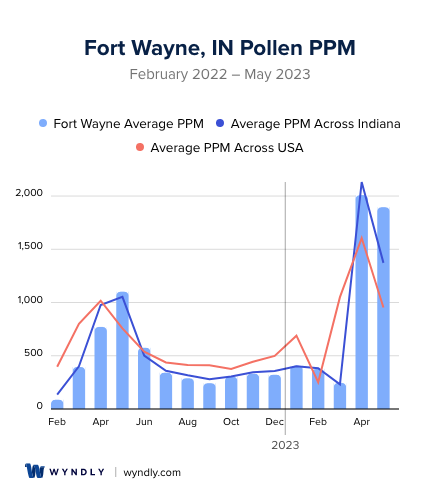
Fort Wayne, IN Pollen and Allergy Breakdown by Month
Grass
When is grass pollen highest in Fort Wayne, IN?
April has the highest grass pollen in Fort Wayne, IN with an average PPM of
When is grass pollen lowest in Fort Wayne, IN?
October has the lowest grass pollen in Fort Wayne, IN with an average PPM of
Tree
When is tree pollen highest in Fort Wayne, IN?
April has the highest tree pollen in Fort Wayne, IN with an average PPM of
When is tree pollen lowest in Fort Wayne, IN?
July has the lowest tree pollen in Fort Wayne, IN with an average PPM of
Weed
When is weed pollen highest in Fort Wayne, IN?
April has the highest weed pollen in Fort Wayne, IN with an average PPM of
When is weed pollen lowest in Fort Wayne, IN?
February has the lowest weed pollen in Fort Wayne, IN with an average PPM of
Fort Wayne, IN Pollen Monthly Breakdown by Pollen Type

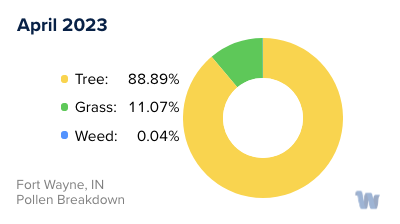

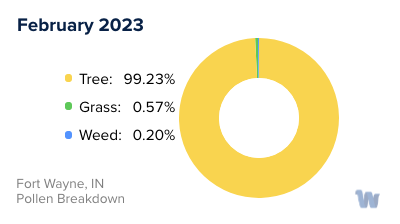
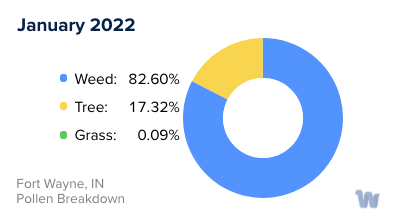

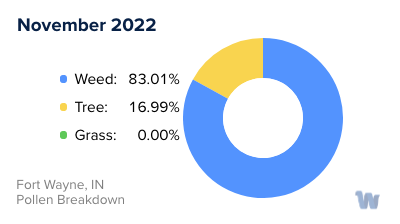
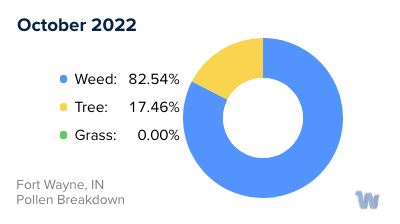

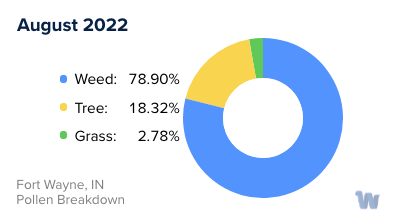

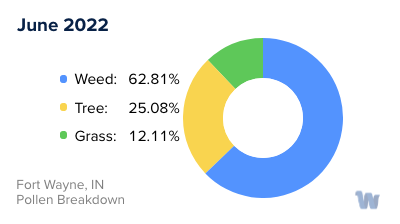
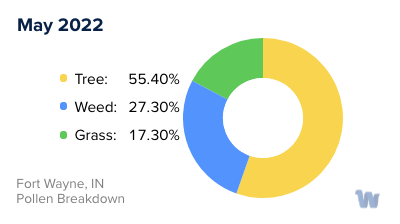
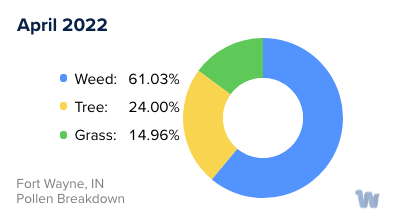


Pollen and Hay Fever in Fort Wayne, IN
Pollen allergies, also known as hay fever, are a common issue for residents of Fort Wayne, Indiana. Three primary types of pollen contribute to these allergies: tree pollen, grass pollen, and ragweed pollen.
Tree pollen is one of the first allergens to appear as winter transitions to spring. Starting in late February or early March, trees such as hickory, oak, maple, willow, ash, privet, cedar, and mulberry begin releasing their pollen into the air. The tree pollen season in Fort Wayne typically tapers off in May, providing some respite to those who are particularly sensitive to this type of pollen.
As spring turns to summer, grass pollen takes the stage. This type of pollen is usually most prevalent from the end of May until August. Grasses such as bent, timothy, sweet vernal, orchard, fescue, and prairie grasses are the most common triggers of grass pollen allergies in Fort Wayne.
Finally, as summer fades into fall, ragweed pollen becomes the primary concern. The ragweed pollen season begins in mid-August and continues until the arrival of the first hard winter freeze. Besides ragweed, other weed allergens include wormwood, sagebrush, amaranth, and orache.
While winter offers a break from outdoor pollen allergies, indoor allergens can still cause issues year-round. Nonetheless, understanding the different types of pollen and their respective seasons can help residents of Fort Wayne prepare for and navigate the challenges of pollen allergies, ensuring they can still enjoy the beauty of their city throughout the year.


